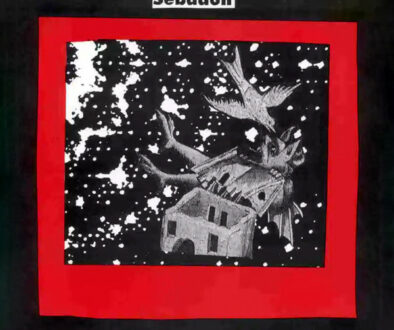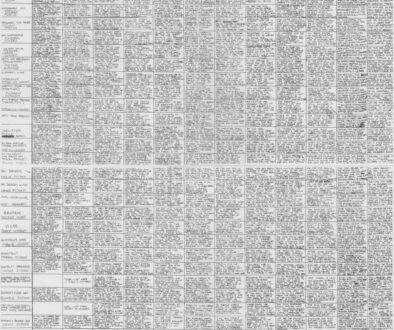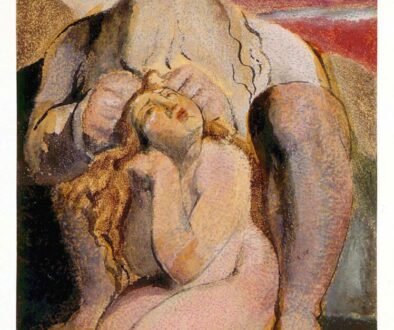 |
| Figure 783: Moore’s family as depicted by Peter Bagge. |
Moore’s other contribution to Honk is a reprint of a piece earlier published by Knockabout Comics, originally with illustrations by Savage Pencil, although the Honk version was illustrated by Peter Bagge. Entitled “Brasso with Rosie,” the piece is one of the few, and by some margin the earliest openly autobiographical piece that Moore has written. It is, to be sure, an exaggerated and at least partially fictionalized piece – Moore’s claim that an elderly relative of his was once “totally immobilized when a thoughtless spouse decided to hang mirrors upon either side of the tiny, damp-scented room in which he customarily sat, presenting the luckless dotard with an infinite succession of doppelgangers arrayed to either side of him,” leading him to believe that he had “been granted some form of X-ray vision, enabling him to see through the peeling walls and into the identical living rooms of his neighbors,” and that “he remained like this for twenty years” is, for example, surely overstating the case by at least half a decade. But underneath the comedic exaggeration is a sardonic and vivid account of the texture of Moore’s childhood, featuring no shortage of details that Moore would go on to revisit in later works, such as his claim that “while it was true that before I was ten years old I had been hung from a tree by my wrists, whipped with barbed wire and buried alive by my schoolchums, there were also moving and poignant memories that I shall carry with me forever,” an account he would eventually revisit in his magical working The Birth Caul. Indeed, “Brasso with Rosie” discusses birth cauls in the context of his grandmother’s “elaborate and obsessive system of Juju and Counter-Juju,” claiming here that she in fact had an “extensive collection” of them that was discovered after her death, as opposed to, in his later account, simply having his mother’s caul.
 |
Figure 784: Moore sardonically depicts the banality of a childhood friend
dying of cancer. (Written by Alan Moore, art by Myra Hancock, from “A True
Story,” in Myra #8, 1986) |
A similarly autobiographical piece appeared in Myra Hancock’s self-published magazine Myra, with illustration by, of all people, Myra Hancock. Entitled “A True Story,” it’s a deliberately shapeless narrative that starts with a couple pages about a childhood acquaintance of Moore’s named Christopher Martin. Moore begins by telling the story of getting into a fight with Martin and punching him, then digresses through some school-age antics, always focusing on odd details, such as the fact that Martin “idolised Manchester United and collected programmes with their picture in the middle. In one, Paddy Brennan’s right testicle was clearly visible.” Halfway through the second of the strip’s five pages, Martin contracts Hodgkinson’s Disease. By the end of the third page, he’s dead. The third page focuses on Moore and his friends’ reaction to his death, which is as drably mundane as everything else in the strip, and finally with Moore running into one of his old friends in the post office and going for coffee, where they reminisce. “He told me that Gavin now has a wife, two kids, and multiple schlerosis,” Moore narrates. “I told him that Jon’s divorced now, and has a job in the police force. We both had a good laugh, without being quite sure why.” And with that, the strip ends, all the drama of confronting death at a young age ultimately expressed only in the trivialities of day to day life, which is, after all, the context in which such things truly exist in the first place.
It is worth pointing out that these independent, small-press works are essentially the only place in which Moore engages in any degree of autobiography. Indeed, in a 2003 interview with Moore, Eddie Campbell enumerated the sum total of autobiographical works of Moore’s that had appeared by that point, counting only four works: the last chapter of Voice of the Fire, The Birth Caul, a piece called “Letter from Northampton” that Campbell describes as “a lightweight page in a mag called Heartbreak Hotel,” and “Brasso with Rosie,” which Campbell notes Moore declined to let him reprint with the interview. Moore, for his part adds “A True Story” to the tally, while pointing out that the last chapter of Voice of the Fire, despite being autobiographical, avoids the first person singular entirely. He also acknowledges “a certain reluctance to appear on the page myself,” while conceding that “it’s really just my particular great vanity to try and conceal my great vanity.” But the fact that Moore does not often write directly about his own life does not mean that this life is any less immediately relevant to understanding his work, and, more to the point, his actions over the course of the War, a topic of growing concern as the actual outbreak of hostilities looms.
 |
Figure 785: The sole remaining portion of Northampton
Castle. |
Many of the basic facts are well known. Moore was born on November 18th, 1953, in Northampton. His parents were working class – his father worked as a manual laborer at a brewery, where he earned £780 a year – about £20,000 today; his mother at a printer’s. He lived in a council house in the Spring Burroughs region of the town, a network of streets built over the old moats and forts of Northampton Castle, demolished in 1662, with both his parents, his brother, and his grandmother, although shortly before he was born there had been a further seven more extended relations living with them. The house was by no means luxurious – it had neither an indoor toilet nor hot water, although it did have electric lighting, which put it ahead of many of the houses in the area. His life was certainly not one of intense deprivation – his family was always able to make basic ends meet and still provide him with a bit of pocket money – but this was in no way a universal experience for the area. Moore is usually sardonic about this, as in his quip that “there were a great many families who were probably, looking back, incest families, where even the dog had the same hairlip,” but occasionally lets slip a detail regarding the degree of deprivation that existed around him, such as the existence of families that couldn’t adequately feed themselves and “whose children had that sort of dull gray skin that I came to associate with undernourishment.”
 |
Figure 786: Jeremy Seabrook’s The
Unprivileged |
While Moore has not written at any great length about his upbringing (although, obviously, it comes up in several interviews), a surprisingly good alternative. Moore’s first-form French teacher was Jeremy Seabrook, who, the year after teaching Moore, penned The Unprivileged, which was the first book in a still-ongoing career writing about poverty. This career would have a global scope, chronicling poverty in India and elsewhere, but The Unprivileged, subtitled “a hundred years of family life and tradition in a working class street,” was semi-autobiographical, with Seabrook telling the history of his own family and upbringing, which took place only a few streets and fourteen years removed from that of his eventual pupil. (Indeed, Moore notes in the short film Don’t Let Me Die in Black and White that his family at large comes from the same street as Seabrook.) Interviewed by Lance Parkin, the first scholar to uncover the connection, Seabrook did not remember Moore specifically, but nevertheless remarked on the character of the Buroughs, an area defined by the then-declining shoemaking industry, saying that “the shoe people were generally narrow, suspicious, mean, self-reliant, pig-headed, but generally honourable and as good as their word.”
And so while The Unprivileged is not, as such, a book about Alan Moore, it is nevertheless profoundly revealing. It is not fair to call it the book Moore would have written about his childhood, but given the biographical similarities of Moore and Seabrook, it’s still one that offers numerous parallels to Moore’s life. Seabrook, for instance, describes the superstitious nature of the area’s inhabitants – the way that “one or two older members of the family still assert that they are able to work harm against those they dislike simply by the power of their will,” and talks about how his family’s superstitions “seem sometimes to have the power to transport me, their slightest more matter-of-fact observations serving as magical incantations, to impossible and fabulous times, when even the wild flowers and birds in Polebrook Woods had a profound and urgent significance for those who lived close to them,” a description that not only seems to prefigure Moore’s eventual psychogeographic approach to magic, but that matches hiss account of his grandmother’s “kitchen corner voodoo” whereby “knives crossed on the dinnertable, as an instance, heralded the forthcoming destruction of the house and its immediate neighborhood by a rogue comet. To avert this peril, the catastrophically crossed cutlery had to be struck forcibly by yet a third knife,” a prime example of Seabrook’s observation that “nearly all of their superstitions connected with the natural world were warnings of imminent death, sickness or loss.” Elsewhere, Seabrook talks about the complex rules of divination that existed around the sparks and embers of the fire, noting that this “ancient elemental source of so many superstitions was frequently consulted as an infallible means of divination,” and in doing so seems almost to call Voice of the Fire (in which Moore namechecks Seabrook) into being.
Similarly, Seabrook provides a litany of idiosyncratic dialect of the region, generally “unaltered Anglo-Saxon,” describing his family talking “of the slommakin neighbors glining at you from behind the curtains, the mardy-arsed children and the blarting women having a tune (crying) over nothing, Vera glawning around (A S ginian, to yawn) as if she wasn’t sharp, the smoke puthering out from the grate when the wind blew down the chimneys, the old man golloping his food, Gran scratting about like a blue-arsed fly, the kids yawping and grizzling in the jitties, the sister who takes tut over nothing, people flacking in and out of the house all day long, the roads all claggy with mud, the shutting-in of the day,” an aspect of life that Moore recalled influencing The Bojeffries Saga, saying, “there were the peculiarities of speech, the little things that your parents or someone that you knew would say. I remember that the expression ‘Duzzy’ that was used in the first episode, that was something peculiar to my first wife’s father, who would use it instead of saying ‘bloody’, or something like that. It was one of those evaisve semi-swear words, which I thought sounded peculiar so I stuck it in the Bojeffries.
 |
Figure 787: Alan Moore in front of Green Street, Northampton, where
Jeremy Seabrook grew up. |
But there is a significant difference in approach here. For Moore, these oddities of speech are an object of wistful nostalgia – an artifact of what Moore, a decade after creating The Bojeffries Saga, described as a “terraced landscape which is becoming increasingly at risk and endangered, and which probably won’t be here too much longer.” But for Seabrook, this dialect is a considerably more sinister detail. “It was possible,” he reflects, “to imagine a vigorous and independent dialect, but none of it was of recent evolution.” He documents the way in which the Green Street culture was simply an ossified relic of a pre-urban culture, shuffled off to the terraces in a feat of Victorian social engineering, explaining how “the language altered little with the immediate change from country to town. It took several generations for the Anglo-Saxon words relating to their craft to fall into oblivion. Some of our family had been thatchers, or thackers as they called themselves, and they continued to use words like yelm for straw, dike for ditch.” Not only was the vocabulary itself archaic, so was the entire tone of speech, with pronunciations that hailed from “the traditional Anglican speech of Mercia, which predated by many hundreds of years anything resembling standard English.” This was not, in other words, a lively dialect, but a decayed relic. As Seabrook puts it, “they could not allow that people adopted another linguistic usage for any other reason than snobbery. It was assumed that theirs was the only natural speech.” Only in the terraces’ final generation did this begin to change, so that “the old find themselves suddenly speaking an unintelligible tongue. All at once the stylized ritual phrases, the mummified images, the fixed inflexions and cadences are full of a plaintive lamenting music. The old are aware of an inability to make themselves understood, even to their own children, and they realize that they will be the last ones to use the dialect.”
 |
| Figure 788: An empty and bleeding socket. |
This sort of sympathetic revulsion towards the culture of Green Street is characteristic of Seabrook’s book. He returns constantly to the closed-mindedness of the area’s inhabitants, describing their hatred of abstract art as “the anger of anyone brought abruptly face to face with ideas which he has no use for, but which he finds form the very basis of someone else’s philosophy. They did not admit it willingly that anything exceeded their ability to understand, and in consequence violence had to be done to everything they encountered in order to accommodate it.” This resulted in attitudes characterized on the one hand by intense suspicion towards “other people [who] were sure to abuse your hospitality, take advantage of your kindness and exploit your generous nature,” and on the other by an intense desire “not to be beholden to anybody.” He describes one group of relations simply as “mean. Of them it was said that ‘they’d bottle a fart and use it again if they could’. Tom’s mother was extremely reluctant to throw away anything she had used personally, and even left the water she had washed in cooling greyly for hours in the enamel bowl in the sink. Once they found some mice-droppings in a sack of flour, and they spent the whole night extracting the tiny black grains from the bag before offering the tainted powder for sale the following morning.” The sense of anti-intellectualism and insularity is profound, and the theme that Seabrook circles back to again and again, concluding that “the life of the streets had a devitalizing effect, and did not allow of any departure from a rigidly fixed pattern of behaviour and relationships.” But for all of this, he speaks movingly of the plight of his family and neighbors, explaining in the book’s final passage how, when the terraces were finally bulldozed in favor of some new vision of social engineering, the now displaced residents were “shown the error and irrelevance of their faith by those who have access to greater truths, and who tear the veils from the eyes of others, veils that prove to be not veils at all, but living membranes, the removal of which leaves nothing but empty and bleeding sockets.” [continued]











May 29, 2015 @ 1:30 am
I know some similar stories in my family and in the communities where I grew up in Scotland – especially from the experiences my mother and father had, and their grandparents.
My father talked to me about his childhood of three in a bed, how he climbed every tree around the estate where he lived and I know that at the age of 14, rather than going up to the 'big school', his father pretty much sent him down to Leith Docks where he was apprenticed as a welder. This was something which he resented and still does to this day as he was one of the smartest kids in his school and had wanted more of an education. I grew up in some of the roughest areas around Edinburgh, and have many memories of playing around burnt out cars that had been set on fire, old canals filled with broken toys, rubbish and old shopping trolleys, all near concrete tower blocks which were pretty scary to live in as a kid. I loved the area though and at least at this time there was no road bypass or industrial estates that have since taken away the rolling land filled with crops and trees.
I found despite the rawness of the territory, many pockets of wonders and magic in the land and in a lot of ways those starnge places we grow up in can feed many tales.
May 29, 2015 @ 1:30 am
This comment has been removed by the author.
May 29, 2015 @ 3:48 am
Hmmm. I call bullshit on this "unaltered Anglo-Saxon" malarkey. Dialects don't work like that. There are differences of degree, but in essence it's not a question of one sort of speech staying the same while another changes, but of different strands changing in different ways.
The idea gets particularly silly when the one example of an Old English root-word quoted is conspicuously unlike the equivalent "unaltered" modern dialect word, while the standard English "yawn" is of course derived from the same OE word, and indeed resembles it more closely. Some of the other examples (like "thackers", or "dike") are also just variant forms of words also found in standard English (in both of those cases cleaving the "k" sound rather than the "tch" sound, both sounds represented in OE as "c"), others (like "claggy") are apparently not OE at all but of much more recent origin, while others (like taking tut") which are expressions rather than words, also seem likely to be of relatively recent origin, or at least not verifiably otherwise.
And “the traditional Anglican speech of Mercia, which predated by many hundreds of years anything resembling standard English” suggests a lack of awareness that standard English is itself derived principally from the dialectical forms of the medieval and early modern Midlands.
The whole contention is a matter of the author exploiting/being deceived by the widespread fallacy by which people think of unfamiliar or unusual words or usages whose earlier forms have been pointed out to them as being "older" than common, familiar words of equally ancient origin.
What you have here is a tendentious philological fiction cooked up to support a particular, not very friendly characterisation of a community.
In a word, cobblers. (I'm sorry. I'm so, so sorry.)
May 29, 2015 @ 3:49 am
cleaving to
May 29, 2015 @ 3:51 am
Oh, I don't know. I rather like "starnge".
May 29, 2015 @ 3:57 am
Cool! Scratch that, I'll delete the apology then as I actually like it too.
May 29, 2015 @ 4:02 am
I've been shaped by the starnge.
May 29, 2015 @ 1:06 pm
I haven't read the original, but I take it the point is not so much that the linguistic claims are objectively true as that they were believed by the people Seabrook was writing about. He could still be full of shit, of course, but if he is I don't think it's in the specific way you suggest.